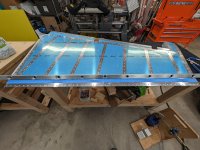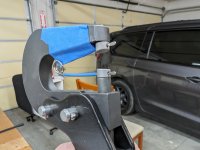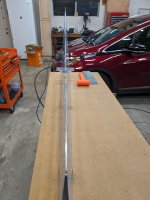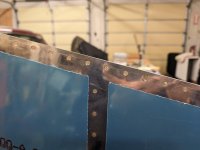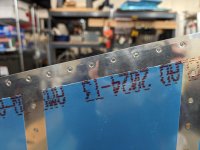I'll soon be working on my RV-14A's rudder trailing edge. I intend to use the double-sided tape method, and would like to use an aluminum angle as an aid to keeping the TE straight during riveting. I plan to squeeze the rivets using Cleveland's AEX TE flat set.
While building my practice kit, I used the aluminum angle to cleco to while applying the double sided tape, resulting in a nice, straight, trailing edge. However, I then removed the angle to squeeze the rivets, and ended up with a probably OK, but less-than-perfect, result. (Note: I did NOT let the tape cure overnight. Should I have?)
I'd like to keep the angle in place while squeezing the rivets, but it's not clear to me what the best strategy is to make it happen. To me, the obvious plan after installing the tape with all TE holes clecoed to the angle, would be to:
Is there a better way to do this? Any suggestions, or pointers to threads/build logs where this process has been well documented, would be appreciated!
While building my practice kit, I used the aluminum angle to cleco to while applying the double sided tape, resulting in a nice, straight, trailing edge. However, I then removed the angle to squeeze the rivets, and ended up with a probably OK, but less-than-perfect, result. (Note: I did NOT let the tape cure overnight. Should I have?)
I'd like to keep the angle in place while squeezing the rivets, but it's not clear to me what the best strategy is to make it happen. To me, the obvious plan after installing the tape with all TE holes clecoed to the angle, would be to:
- Identify next batch of holes in which to install rivets.
- Un-cleco rudder from angle.
- Use a step drill to enlarge the batch of holes in the angle large enough to accommodate the the flat set.
- Re-cleco the rudder to the angle.
- Partially squeeze (per the plans) the batch of rivets.
- Lather, rinse, repeat until all rivets are partially set.
Is there a better way to do this? Any suggestions, or pointers to threads/build logs where this process has been well documented, would be appreciated!



